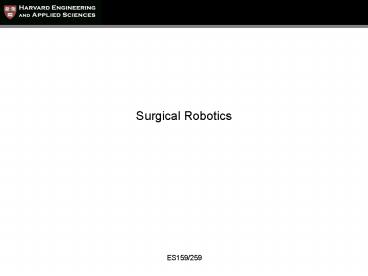Surgical Robotics PowerPoint PPT Presentation
1 / 33
Title: Surgical Robotics
1
Surgical Robotics
2
Updates
- Lab 5 starts this week (last lab)
- Lab 4 writeup due Thursday 4/26
- Next lecture on grasping, very special guest
lecturer - Robotics conference/exposition
- http//www.roboevent.com/
3
Introduction
- Surgical robotics is a classic application of
manipulator design and control - Motivations why do we want to use robots in a
surgical application? - Repeatability (precision)
- Smaller incisions (less trauma)
- Versatility (surgeon doesnt need to be in the
same room) - Procedures on active organs (i.e. potentially a
beating heart) - Lower costs
- Current drawbacks
- Lack of dexterity
- Lack of sensory information
- Force feedback
- Tactile feedback
- Visual feedback
- High cost
4
Robot-Assisted Surgery
- Thoracic
- Epicardial lead Placement
- Chondroma
- Esophagectomy
- IMA Harvest
- IMA Takedown
- Lobectomy
- Lung Biopsy
- Nodulectomy
- Thymectomy
- Tumor resection
- Urology
- Donor Nephrectomy
- Prostatectomy
- Ureter Harvest
- Vascular
- Aortic Abdominal Aneurysm
- Cardiac
- Atrial Septal Defect Repair
- Mitral Valve Repair
- TECAB - Totally endoscopic coronary artery bypass
- General
- Adrenalectomy
- Cholecystectomy
- Esophagatomy
- Gastric Bypass
- Heller Myotomy
- Nissen Fundoplication
- Gynecology
- Cystocele Repair
- Hysterectormy
- Tubal Ligation
- Tubal Reanastomosis
5
Introduction
- Outline
- Introduction to minimally invasive surgery
- Teleoperation
- Examples
- Haptics and tactile feedback
6
Minimally invasive surgery
- Also called laparoscopic surgery
- The process of entering the body through small
ports rather than large incisions - Reduced trauma
- Reduced overall cost
- Typically involves at least three ports one for
a camera and two for manipulators
7
Minimally Invasive vs. Open Cholecystecomies
(Thousands, U.S., 1996)
gt 80 Cholecystecomies done with MIS! (likewise
for many other surgeries)
8
Minimally Invasive Surgery
- Operations through small incisions
- Reduced trauma to healthy tissue
- Less pain, shorter hospital stay
- Reduced cost -- Patient returns to work sooner
- However, more difficult technique due to reduced
access, dexterity, and perception - Limited dexterity due to only having 4 DOF
- Reduced force feedback
- No tactile feedback
- Reduced hand-eye coordination
- Problems in spatial planning
- Many procedures cannot be performed with current
MIS technology or are extremely difficult
9
Overcoming MIS Limitations
- Replace the surgical instruments with robotic
manipulators controlled by the surgeon through
teleoperation - Increase dexterity by added DOFs
10
Teleoperation
- Teleoperation means simply to operate a vehicle
or a system over a distance - Distance can vary from tens of centimeters (micro
manipulation) to millions of kilometers (space
applications) - (fancy word for remote control)
- Operator (master) human operator is the person
who monitors the operated machine and makes the
needed control actions - Teleoperator (slave) the teleoperated machine. A
sophisticated teleoperator can also be called as
telerobot
11
Definitions
- Mechanical manipulation
- The control commands are transmitted mechanically
or hydraulically to the teleoperator. Visual
feedback can be straight or via monitor. - This is typical for manipulation of dangerous
materials as well as micro manipulation
12
Definitions
- Closed loop control (Direct teleoperation) The
operator controls the actuators of the
teleoperator by direct (analog) signals and gets
real-time feedback. This is possible only when
the delays in the control loop are minimal. - Coordinated teleoperation The operator again
controls the actuators, but now there is some
internal control - remote loop - included.
However, there is no autonomy included in the
remote end. The remote loops are used only to
close those control loops that the operator is
unable to control because of the delay. - Supervisory control low-level control is at the
teleoperator end (compare coordinated
teleoperation). The teleoperator can now perform
part of the tasks more or less autonomously,
while the operator mainly monitors and gives
high-level commands. The term task based
teleoperation is sometimes used here, but it is
more limited than "supervisory control".
13
Closed loop/Supervisory control
14
MIS end effector concepts
Integrated Yaw Pitch (Single Joint)
5 DOF
Multi-Fingered Hand
15
MIS end effector concepts (cont)
16
Input devices
17
Example Unimanual Telesurgical System
18
Example surgical arm
19
Matched Robot Arm Kinematics
Canula
Identical Kinematics
Robot Arm
Master input
20
Telesurgery Concept
21
Da Vinci System
- FDA - approved
- Insite Vision System
- Endowrist Instruments
- Video Tower
22
Da Vinci Cart
- Endowrist instruments
- 3-4 robotic arms
- Interchangeable end effectors
23
Da Vinci Console
- 3D vision
- Stereoscopic
- Maser controls
- Camera controls
24
Da Vinci System
Robot arms
Video display
console
patient
surgeon
25
Da Vinci System
- Master controller controls the motion of the end
effector wrist
Surgeon at console
Master input
26
Da Vinci System
- Multiple robotic arms
- For camera control and end effector control
Stereo endoscope
7DOF end effector
27
Example surgery
- Patients chest is distended with CO2 to give
room for the manipulators to operate
Ports called trocars
28
Example surgery
- Connection between the robotic arm and the patient
Robotic arm enters the patient through the trocar
29
Example surgery
- Camera view
30
haptics
- Sensory information pertaining to touch
- Invaluable to surgeons performing laparoscopic
surgery - Tactile v. force feedback
- Force feedback gross forces transmitted to
master - Tactile feedback detailed surface forces
transmitted to master
31
Tactile feedback
- teletaction concept tactile feedback from
catheter
32
Tactile displays
- Various morhpologies
- Normal contact
- Pneumatic
- Pin-based
- SMA
- Shearing
- piezoelectric
33
Next class
- Outline of active research areas
- Mobile robot navigation
- Sensors and actuators
- Computer vision
- Microrobotics
- Surgical robotics
- Grasping

